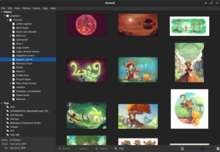GNOME Foundation is a non-profit organization based in Orinda, California, United States, coordinating the efforts in the GNOME project.

digiKam is a free and open-source image organizer and tag editor written in C++ using the KDE Frameworks.

GNOME Terminal is a terminal emulator for the GNOME desktop environment written by Havoc Pennington and others. Terminal emulators allow users to access a UNIX shell while remaining on their graphical desktop.
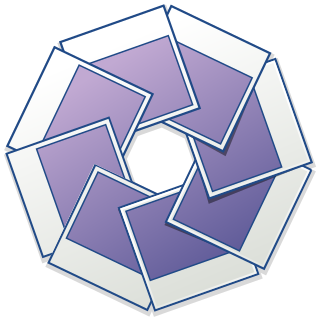
F-Spot is a slowly maintained image organizer, designed to provide personal photo management for the GNOME desktop environment. The name is a play on the word F-Stop.
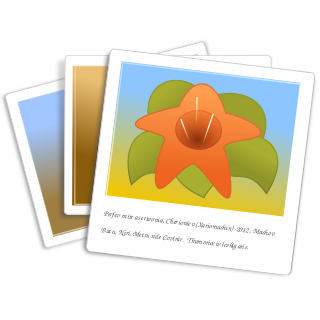
gThumb is a free and open-source image viewer and image organizer with options to edit images. It is designed to have a clean and simple user interface and follows GNOME HIG, it integrates well with the GNOME desktop environment.

Compiz is a compositing window manager for the X Window System, using 3D graphics hardware to create fast compositing desktop effects for window management. Effects, such as a minimization animation or a cube workspace, are implemented as loadable plugins. Because it conforms to the ICCCM conventions, Compiz can be used as a substitute for the default Mutter or Metacity, when using GNOME Panel, or KWin in KDE Plasma Workspaces. Internally Compiz uses the OpenGL library as the interface to the graphics hardware.
A desktop environment is a collection of software designed to give functionality and a certain look and feel to an operating system.

Linux Mint is a community-driven Linux distribution based on Ubuntu, bundled with a variety of free and open-source applications. It can provide full out-of-the-box multimedia support for those who choose to include proprietary software such as multimedia codecs. Compared to Ubuntu, it uses a different Cinnamon interface by default, using a different, more traditional layout that can be customized by dragging the applets and creating panels. New applets can also be downloaded.

Empathy is an instant messaging (IM) and voice over IP (VoIP) client which supports text, voice, video, file transfers, and inter-application communication over various IM communication protocols.

Ubuntu releases are made semiannually by Canonical Ltd, the developers of the Ubuntu operating system, using the year and month of the release as a version number. The first Ubuntu release, for example, was Ubuntu 4.10 and was released on 20 October 2004. Consequently, version numbers for future versions are provisional; if the release is delayed until a different month to that planned, the version number will change accordingly.

GNOME 3 is the third major release of the GNOME desktop environment. A major departure from technologies implemented by its predecessors, GNOME 3 introduced a dramatically different user interface. It was the first GNOME release to utilize a unified graphical shell known as GNOME Shell. It also introduced support for the Wayland display protocol and added integration with other key technologies such as Flatpak during its development lifecycle.
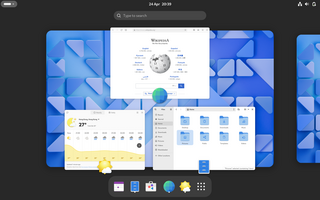
GNOME, originally an acronym for GNU Network Object Model Environment, is a free and open-source desktop environment for Linux and other Unix-like operating systems.

GNOME Shell is the graphical shell of the GNOME desktop environment starting with version 3, which was released on April 6, 2011. It provides basic functions like launching applications, switching between windows and is also a widget engine. GNOME Shell replaced GNOME Panel and some ancillary components of GNOME 2.

Unity is a graphical shell for the GNOME desktop environment originally developed by Canonical Ltd. for its Ubuntu operating system. It debuted in 2010 in the netbook edition of Ubuntu 10.10. Since 2017, its development was taken over by the Unity7 Maintainers (Unity7) and UBports.

Fuduntu Linux was a Fedora-based Linux distribution created by Andrew Wyatt. It was actively developed between 2010 and 2013. It was designed to fit in somewhere between Fedora and Ubuntu. It was notable for providing a 'classic' desktop experience. Although it was optimized for netbooks and other portable computers it is a general-purpose OS.
Fedora Linux is a popular Linux distribution developed by the Fedora Project. Fedora attempts to maintain a six-month release schedule, offering new versions in May and November, although some releases have experienced minor delays.

Cinnamon is a free and open-source desktop environment for Linux and Unix-like operating systems, deriving from GNOME 3 but following traditional desktop metaphor conventions.
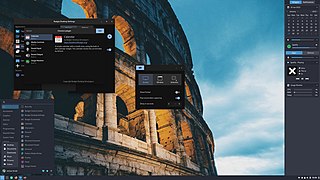
Budgie is an independent, free and open-source desktop environment for Linux and other Unix-like operating systems that targets the desktop metaphor. Budgie is developed by the Buddies of Budgie organization, which is composed of a team of contributors from Linux distributions such as Fedora, Debian, and Arch Linux. Its design emphasizes simplicity, minimalism, and elegance, while providing the means to extend or customize the desktop in various ways. Unlike desktop environments like Cinnamon, Budgie does not have a reference platform, and all distributions that ship Budgie are recommended to set defaults that best fit their desired user experience.

Ubuntu Budgie is an official community flavor of Ubuntu. It combines the Ubuntu-based system with the independently developed Budgie desktop environment.

